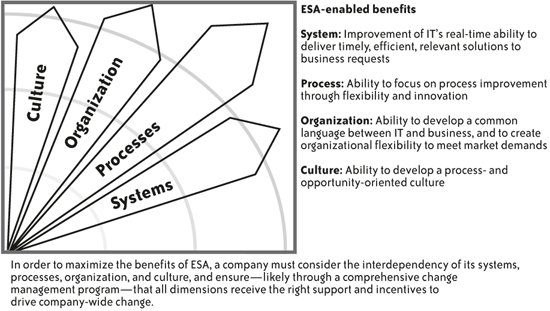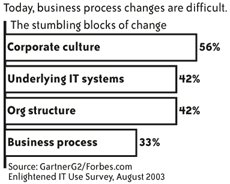Section 3.7. What is IT s role within ESA?
3.7. What is IT's role within ESA?The relationship between the business staff and IT too often is based on obsolete assumptions. That's a good thing because up until now, at times it has not been the best relationship. The relationship between IT and line managers, such as it is now, often boils down to a requirements document: the business side decides what it needs built, and IT is expected to build it. Management doesn't have to peer under the hood, and IT is neither qualified nor expected to ask whether the business side is asking the right questions or has settled on the best solution. This cultural disconnect may lead to a solution that does too much or too little. Figure 3-2. To achieve ESA benefits, systemic change management is required Obviously, in a nightmare scenarioor in the world of Dilbertthis is a suboptimal, codependent relationship. Neither side is motivated to understand the limits, capabilities, or opportunities of the other side, nor has the expertise and knowledge to do so anyway. As Figure 3-3 shows, this cultural barrier looms large. The conversations between the two are usually limited to the solution at handa new application, an integration task, etc.rather than the underlying business issues. Answers are built or discussed, but the true questions facing business remain murky. There is a depressing chicken-and-egg aspect to this dilemma. Does this disconnect inhibit IT's flexibility and adaptiveness to ever-accelerating rates of business change, or is it a product of a monolithic architecture in which business logic is buried under layers of application programming interfaces (APIs) and even more arcane interfaces? And does it really matter? It should be obvious to everyone that you can't solve the flexibility issue by adopting ESA without solving a far more fundamental issue: both sides need to understand business processes before they can adopt ESA. And that's an organizational and a cultural issue, not a technological issue. Figure 3-3. The obstacles of business process change |
EAN: 2147483647
Pages: 265